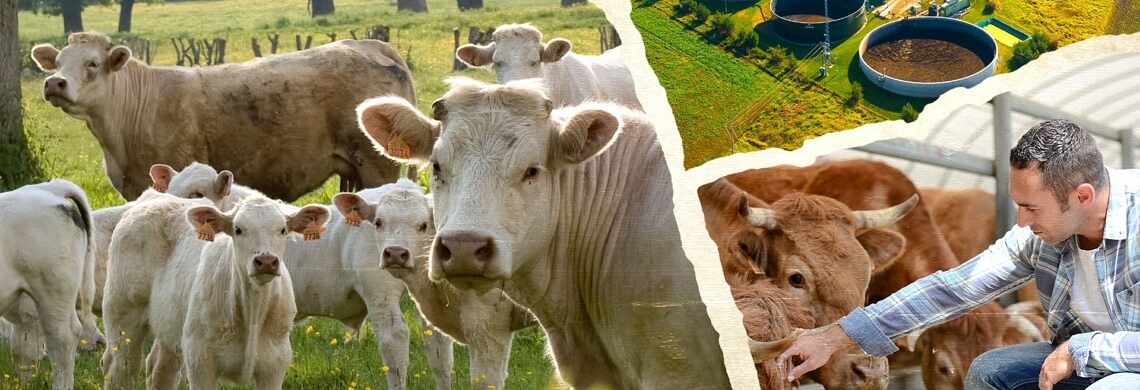Many consumers from various corners of the globe have been convinced that European beef is characterized by a unique taste and high quality. The meat owes its qualities, among others, to the strict production standards in force in the Community – but not only that! The tradition cultivated by EU breeders is equally important.
The beginnings
The European tradition of cattle breeding dates back to the Neolithic era, thus reaching 7000 BC. It was then, as researchers suppose, that the ancestors of today’s inhabitants of Europe began to domesticate cows, which was related to the change of lifestyle from nomadic to sedentary. From then on, they gradually became skilled at cattle breeding, developed habits and set paths for future generations to follow.
Favourable conditions
The lands of the Old Continent and their structure have always favoured cattle breeding, providing animals with appropriate climatic and natural conditions. A large number of natural pastures also helped dynamically developing farms. All this resulted in the development of many rural areas in Europe. For example, they cover up to 90% of Germany[1] and 93% of Poland[2].
Nurtured for years
Agricultural and breeding traditions in Europe developed very dynamically and on many levels, at the same time becoming very strongly rooted in Europeans. To this day, farmers from EU Member States respect and cherish local customs. This is manifested, among others, in the transfer of industry knowledge from generation to generation; and the farms themselves from the hands of the parents to the hands of the children. In addition, it strengthens the bond that European breeders have with both their land and the animals they devote themselves to breed with full commitment.
For the sake of animals
The attachment of European breeders to their livestock means that care for animal welfare has become extremely important throughout the EU. The Community constantly updates regulations in this area, ensuring that the natural needs of a given species are met. In the EU, the care of animals is part of providing them with the so-called “five freedoms”:
- freedom from hunger and thirst,
- freedom from discomfort,
- freedom from pain, injury, and disease,
- freedom from fear and distress,
- freedom to express normal and natural behaviour.
Thus, EU breeders ensure that animals have constant access to fresh water and food, as well as shelter and a place to rest. Prophylaxis and veterinary treatment are used. Great emphasis is placed on the proper treatment of animals, providing them with space and ensuring the company of other representatives of the same species.
European pedigree
EU breeders also take care to keep individual breeds of cows pure – and it’s worth knowing that over the years a lot of them have developed! Many EU Member States can be proud of their native breed of cattle. For example, Belgium is famous for the Belgium Blue, France for the Limousine breed, and Switzerland for the Simmental breed. Individual breeds show significant differences in appearance, rate of maturation or level of fatness.
To the delight of the palate
Cultivating tradition and care for the purity of breeds remain important also because of the preservation of the taste of meat obtained from cows. In order to protect farming and culinary heritage, the EU has regulations aimed at promoting food produced using traditional methods and local raw materials. Names and legally protected symbols used to mark products have also been introduced, thanks to which the original recipe is preserved.
Tradition and modernity
However, tradition, firmly established in Europe, does not exclude modernity. EU meat plants combine the best of tradition with innovative methods and advanced technologies. The Community also promotes future-oriented solutions focused on the good of the environment, such as the dissemination of the circular economy, as well as the widespread use of the traceability system of the production process. This allows us to constantly develop the meat sector, and at the same time meet the high expectations of consumers.
High quality, great taste
All this makes beef produced in the EU branded with high quality and distinctive taste. It is created to delight even the most demanding palates. Dishes prepared with meat from the EU can connect not only generations, but also cultures from various corners of the world – regardless of whether the beef is presented in the form of a juicy roast, hearty ramen or dim sum filling.
Sources:
- Statistics Poland. Obszary wiejskie w Polsce w 2020r. [Rural areas in Poland in 2020], Warszawa, Olsztyn 2022.
- Józef Bulla, Jan Murgasz, Robert Bulla, Jan Szarek, Tadeusz Szulc, Andrzej Filistowicz. Trendy w hodowli bydła w Europie Środkowo-Wschodniej na przykładzie Słowacji i Polski [Trends in cattle breeding in Central and Eastern Europe on the example of Slovakia and Poland], Przegląd hodowlany no. 12/2010.
- M. Zjalić, A. Dimitriadou, Andrea Rosati. BEEF PRODUCTION IN THE EUROPEAN UNION AND
THE CAP REFORM. An overview of situation and trends.
- https://www.naukowiec.org/wiedza/geografia/rozmieszczenie-hodowli-wybranych-zwierzat-w-europie_3094.html https://polen.diplo.de/pl-pl/02-themen/-/2212918




)
)